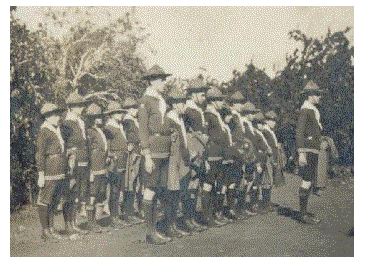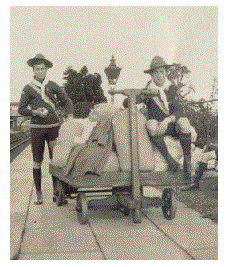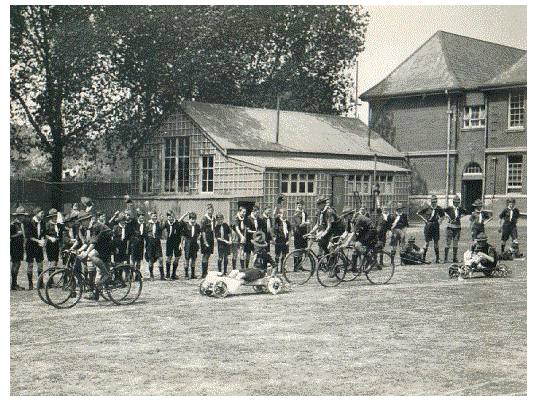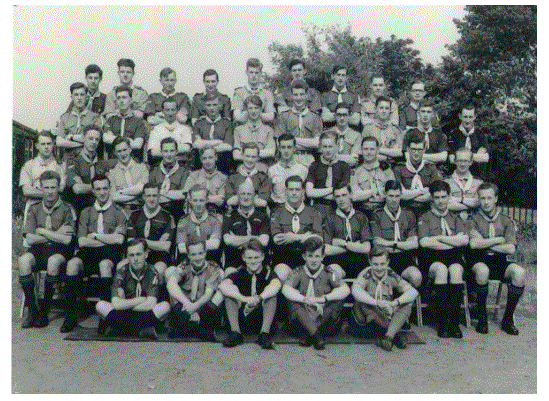

The Scouts at Harrow County
By Alex Bateman
Alongside the Cadets at Harrow County, the most well known and often seen sight was that of its Scout Troop. However, unlike its service cousin, the troop had its birth some 30 years before.
The first mention of Scouts in relation to the School, came in the March 1911 edition of 'Gaytonian' the School magazine. It noted that in the most recent issue of School World, there was an interesting article on "Scouting for Boys in Higher Schools", and invited parents and boys thoughts on the subject, adding that if there was sufficient response, thought would be given to raising a Harrow County Troop.
The then Headmaster, Ernest Young was interested in the idea, so much so that he invited the Chief Scout, and founder of the movement four years before, Sir Robert Baden Powell, to come to the School to give a talk to the parents. On November 16th 1911, the hall was packed and those present left enthralled and enthusiastic about starting a troop.
Within a week, 145 boys had enrolled in the new troop, leaving only 37 who didn't. They were formed into 18 patrols, bearing names such as 'Curlew', 'Panther', 'Eagle' and 'Peewit'. The title allocated to them were the 4th (Harrow County) Troop, the first Scout Troop in the world to be raised in a school. The event attracted a great deal of interest in the national press also, who referred to the School as pioneers, and talking of history being made.
By March 1912, numbers had passed 160 and two more patrols had been added. A new magazine, 'The Patrol' had also been started, and the first camp, held on the School field, was planned. This began on May 7th that year, and it was noted that all Scouts should bring, amongst other things, ' sufficient tea, cocoa, sugar, etc and any delicacies his fond mother will provide for him"!! At this time the Troop possessed only three tents of its own, so the boys had to take turns in using them, a week each. Ernest Young supervised the first week himself.
Later that year, between the 1st and 14th of August, the first summer camp was held at Littlehampton (at a cost of thirty shillings!), while another party visited Germany and Switzerland. A letter was later received from Basle saying as a result of the 4th Harrow visit, a Troop had been formed at the main school in that city. By November 1912, a year after it was raised, the Troop had grown to 22 patrols and almost 200 members. Apart from the camps, the Troop had also taken part in a large military tournament at Olympia, and a mass rally at Uxbridge. In 1914 they won the Harrow District Association Cup for being the Best troop.
The First World War
When war was declared in 1914, the school itself was coming to the end of its summer holiday, and in fact a party of Scouts from the School troop, consisting of eight boys and two Masters, was in the midst's of a short tour of southern Germany. The trip started well, but within a few days, things had become chaotic. They began to encounter formations of soldiers, and often at places they stopped, the only food available was for the German military. A decision was made to return to England, and after a longer return trip through the Rhine Valley, the Scouts caught the last train bound for the Belgian border, which they crossed at about midnight. They found out later that it had been closed only two hours after they left. Arriving back on the Sunday evening, one of the boys later noted that in the proceeding four days, they had slept properly only twice, and had had only two good meals.
Members of the 4th Harrow later acted as messengers and general help to soldiers camped in and around Harrow on their way to the coast (and eventually to France), and guarded local bridges, worked as telephone operators, assisted in the fields etc. A band was also formed at the request of the local 'Volunteer Regiment' (similar to the WW2 Home Guard) and they led the VR on many parades. The band, some 40 strong, was disbanded at the end of the war.
![]()


Most of the 18 Old boys of the school (including two Masters) who died during the First World War had been members of the 4th Harrow Troop, and their deaths were reported in the 'Gaytonian', accompanied by the Scout 'gone home' sign.
Into the 1920s and 30s
After the war, the 4th Harrow was reformed into five separate Troops, A, B, C, D and E, although in May 1919 C Troop was split between A and E. later that year they won the Jabez-Barnes Cup for the first time, and organised a Patrols Leaders conference. In 1920, the first Scout Jamboree was held at Olympia, and 20 members of the School troop took part, alongside Scouts from all over the World. Four years later they helped to organise the Imperial Jamboree held at Wembley.
Possibly the most important event of the 1920s, or even the whole life of the Troop was the formation in 1926 of the 4th Harrow Rover Crew, with 10 Rovers and Jack Beet as Rover Leader. The School Troop was again reorganised at about this time, being divided into 'House Troops', Kenton, Welldon, Northwick and Preston.
The troop came of age in November 1932, and began the celebrations with a camp on the School field in July 1933, opened by the International Commissioner Hugh Martin. Other events included a concert, indoor and outdoor demonstrations, a reunion dinner and on July 9th 1933, a Church service.


Further reorganisation of the Troop came in 1938, with the House system being replaced by Form Troops. These were the Second Form Troop (later to become the Merrymen Troop), the Third Form Troop (later the Pioneers) and the rest of the School becoming the Senior Troop (later the Pathfinders). The idea was that a fourth Troop would be added in 1939, but with the onset of the Second World War, this never came to fruition. Instead, the three Troops developed in their own way. Around this time, a new 4th Harrow magazine appeared, 'Endeavour', replacing 'The Patrol' which had by then ceased to be.
![]()

Another blow to befall the Troop in 1939 was the loos of its headquarters, the famous 'Pavvy'. This had been given to the School in 1913 by the local Education Authorities, having previously been in use as a school in Alperton. It had also been used as a Cricket Pavilion (hence the name) before the school gained its own purpose built one in 1924. With extensions to the School being built in the late 1930s, a new Headquarters was to be included. However, building was suspended due to the war, and afterwards the much needed space was given over to classrooms.
The
Second World War
With a great shortage of Scout leaders, numbers down to one Troop and no proper Headquarters, the 4th Harrow situation looked quite bad at the start of the war. However, meetings were still held in the School hall, and the old 19th Harrow Headquarters, and as things improved, numbers rose again, and camps went on.
The Scout movement raised a new formation in 1941, known as the Air Scouts. It was mainly for those with a duel interest in the air and in Scouting, and the Pioneers changed to become an Air Scout Troop. War duties were similar to those carried out 25 years before, while the Rover Crew kept in touch as far as possible with those on Active Service. The School lost some 147 Old Boys during the Second World War, many of which had again been members of the Troop.
Peace
and the Future
Scouting underwent a radical change after the war, one such being the official institution of Senior Scouting. The 4th Harrow Senior Section was raised in 1948, but disbanded after some two years, it being found more practical owing to the large numbers to attach Senior Scouts to the existing Troops.
With numbers steadily increasing again, the need for a fourth Troop was again raised, and so in 1951, two members of staff, Harry Mees and Mervyn Morgans founded the Forester Troop. The following year the 4th Harrow officially celebrated its 40th birthday, with the events opened by the Chief Scout, Lord Rowallen. These included the first 4th Harrow show "Fourth's Goings On" in the School Hall.
In 1953 the Troop were honoured to have a play, "The Story of Mike", written for them by Ralph reader of 'Gang Show' fame. It played in the School Hall and turned out to be so popular that it was repeated the following April, and again at a club in London. Another Troop magazine was founded at this time also, 'Scouting About'. Ten years later in 1962, a fourth magazine appeared, published by the Pathfinder Troop called 'Signpost', although like its predecessors its run was relatively short.


With the strong footing of the Cadet force at the School, the Troop was always fewer in number. Dr. Simpson expected that boys joined one or the other, and few escaped, although most enjoyed the activities offered. With his retirement in 1965, the feeling of 'conscription' somewhat diminished and numbers in both organisations naturally began to fall.
November 1971 saw the Diamond Jubilee of the 4th Harrow, but they were still without a permanent home. With the loss of the 'Pavvy' before the Second World War, the School Troop had been looking for a base ever since. £3000 had been offered for space in the new buildings at the School but this was not to be. In the early 1970s however, the prospect took an upward turn. Finance was secured from the Department of Education and Science and the local Council, with the balance coming from the Troops own funds. A proposed new building was planned in nearby Kenton, with pleas continuing for equipment, furniture and additional funds.
By 1972, the new building was almost ready, but tragedy arrived in the form of a fire which all but destroyed it. An act of arson, it put the plan back to square one. However all was not lost, and despite some additional costs, the insurance allowed the completion of a new building the following year. It was officially opened by Ralph Reader on September 15th 1973, having cost some £35,843.
The new home, although wanted and needed for so long, meant that the Troop was now based permanently outside the School. Camps continued to be held over the following years on the School field, and as always they joined with the cadets to form a Colour Party and lay a wreath at the School's annual Remembrance Day service. However, by the late 1980s, the Troop had become more of an 'open unit', recruiting few from the School. The annual camp had ceased to be held at the School, and with the ending of the Remembrance Day service in 1994, the last sign of the 4th Harrow at the School went also.
The Troop still thrives, but now has no association with the School.